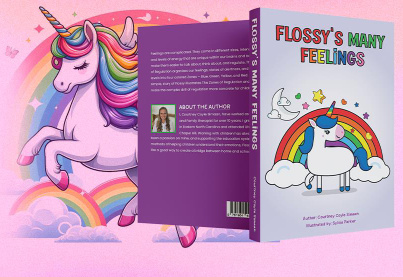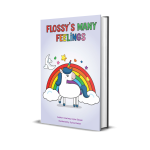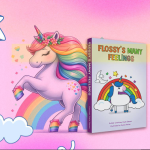
Every child needs to Understand and manage their emotions is a vital skill to learn.
Teaching them emotional intelligence is more important than before.
Children frequently experience intense emotions and are unable to handle them.
This is where the idea of the Zones of Regulation is useful.
It’s a structure that aids kids in controlling their feelings.
Putting them into “zones” to make them easier to understand.
In this wonderful book “Flossy’s Many Feelings” by Courtney Coyle Simaan. Young readers to accompany “Flossy” on an adventurous adventure.
Flossy goes through a lot of emotions during the course of her day. She experiences happiness, excitement, annoyance, and despair.
This book offers kids important concepts in addition to telling a delightful story. Like the Zones of Regulation, it assists people in understanding and controlling their emotions.
How they may teach kids ways of coping and increase their emotional awareness.
This blog will discuss the connections between “Flossy’s Many Feelings” and the Zones of Regulation as well as why young children should read this book.
Additionally, Flossy’s adventures will teach you some important lessons. How they may teach kids coping skills and improve their emotional awareness.
What Are the Zones of Regulation?
Let’s review the Zones of Regulation before starting Flossy’s adventure.
To help kids, Leah Kuypers introduced the Zones of Regulation.
It organizes feelings into four color-coded zones:
-
Blue Zone: This is when you’re feeling low energy, like sad, tired, or bored.
-
Green Zone: The green zone is the “good to go” zone. You feel calm, focused, and ready to learn.
-
Yellow Zone: This is when you have higher energy, like feeling frustrated, anxious, or excited.
-
Red Zone: The red zone is when your emotions are out of control. Like when you’re angry.
Each zone is important. It helps kids understand how they’re feeling. It also shows them what they need to do to return to the green zone. In the green zone, kids feel most in control and ready to take on the world.
Meet Flossy the Unicorn:
Flossy is a cute unicorn with rainbow colored hairs. She is the ideal character to help young readers understand their emotions. Like many children, Flossy experiences a rush of emotions. It’s acceptable for everything to feel overwhelming on some days!
Flossy’s adventure takes her through many situations that change her emotions.
Sometimes she feels happy and excited when she flies high in the sky.
She also feels frustration when things don’t go her way.
Flossy’s Emotions and the Zones of Regulation:
As Flossy goes through her day, young readers can see how her emotions fit into the Zones of Regulation:
-
Blue Zone: Flossy feels tired after a long day of playing with her friends, or a little sad when she feels left out.
-
Green Zone: She feels calm and happy when she’s surrounded by her friends or when she’s relaxing by a crystal-clear stream.
-
Yellow Zone: When things don’t go the way she wants, Flossy gets frustrated and her energy rises. She might feel nervous or anxious about a new challenge she has to face.
-
Red Zone: In moments of intense emotions, like when she’s really upset or angry, Flossy feels out of control.
But don’t worry – throughout the story, Flossy learns how to manage these emotions, and she discovers helpful tools that kids can use too!
How “Flossy’s Many Feelings” Teaches Emotional Regulation:
One of the best things about “Flossy’s Many Feelings” is how it teaches youngsters too easy tactics they can use to manage their emotions.
Flossy gains a number of mindfulness skills that enable her to relax when her emotions become overbearing.
Let’s look at some of the key tools Flossy uses and how they relate to the Zones of Regulation:
1. Deep Breathing
When Flossy is feeling nervous or disturbed, she takes deep breaths. This method aids in her relaxation.
It can be used by many children and even adults to return to the green zone after being in the yellow or red zone. Flossy improves her emotions by breathing deeply and slowly.
2. Positive Self-Talk
Another important strategy Flossy learns is positive self-talk. When she feels sad, she tells herself that it’s fine to have these emotions. This helps Flossy move from the blue or yellow zone back to the green zone. Children can learn from Flossy that it’s important to be kind to themselves. Especially when they’re struggling with big emotions.
3. Taking Breaks
Sometimes, Flossy needs to take a break when her feelings become too overwhelming. Whether it’s finding a quiet spot to relax or doing something she enjoys, taking a break helps Flossy regulate her emotions. Kids can learn from this example that it’s okay to step away when things feel too hard – this is a great tool for moving back into the green zone.
4. Practicing Gratitude
Throughout the story, Flossy also practices gratitude, focusing on the things that make her happy. This helps her stay in the green zone and feel content. Kids who learn to see the good feel stronger and more balanced.
Why Emotional Regulation important for Kids:
Learning to understand and manage emotions is important for children. This skill will benefit them throughout their lives.
When kids have tools to control their emotions, they can focus better. They can also communicate with others and handle challenges more effectively.
The way that “Flossy’s Many Feelings” teaches these abilities is fun.
Reading “Flossy’s Many Feelings” helps adults talk about feelings with kids.
Following Flossy’s journey shows kids that everyone has feelings. It also teaches them the ways to deal with those emotions.
How “Flossy’s Many Feelings” Encourages School Zones of Regulation:
Many schools are using the Zones of Regulation to improve social emotional learning.
For classrooms that highlight emotion control, “Flossy’s Many Feelings” is a best book.
By having students identify the zone that Flossy is in at various points throughout the narrative, teachers can utilize this book to reinforce the concepts.
For example:
- When Flossy is feeling happy and calm, what zone is she in?
- When Flossy is feeling angry or upset, what zone does that represent?
- How does Flossy move from the red zone or yellow zone back to the green zone?
These kinds of discussions can help children better understand their own feelings and recognize what zone they are in throughout the day.
Conclusion: Helping Kids Grow Emotional Intelligence with Flossy:
The narrative “Flossy’s Many Feelings” is fun and amazing. It’s also an effective way to teach children about emotions.
Young readers will discover via Flossy’s highs and lows that it’s acceptable to feel these emotions. More significantly, they will learn more effective ways to cope for those emotions.
So, grab a copy of “Flossy’s Many Feelings” today, Help your child build emotional intelligence.







Leave a Reply